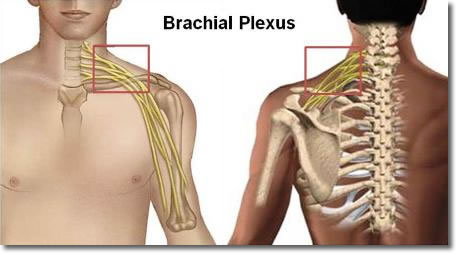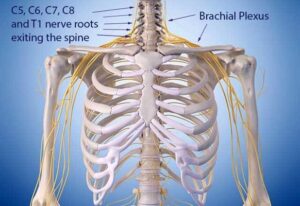
Brachial plexus injuries
The brachial plexus is a bundle of nerves that stems from nerve roots in the cervical (neck) and upper trunk (torso) sections of the spinal cord (C5-T1), creating a network that connects to the nerves in the arm. These nerves control the motions of your wrists, hands and arms, allowing you to raise your arm, type on your keyboard or throw a baseball.

The brachial plexus nerves extend to the skin and are sensory, too. For instance, they let you know that the pan you just grabbed with your hand is too hot to hold.
- Ulnar nerve: Rooted in C8-T1, it allows for fine motor control of the fingers.
 Brachial Plexus Anatomy
Brachial Plexus Anatomy
The brachial plexus can be injured in many different ways — from pressure, stress or being stretched too far. The nerves may also be cut or damaged by cancer or radiation treatment. Sometimes, brachial plexus injuries happen to babies during birth.
Brachial plexus injuries cut off all or parts of the communication between the spinal cord and the arm, wrist and hand. This may mean that you can’t use your arm or hand. Often, brachial plexus injuries also result in total loss of sensation in the area.
The severity of a brachial plexus injury varies, depending on the part of the nerve that is injured and the extent of the injury. In some people, function and feeling returns to normal, while others may have lifelong disabilities because they can’t use or feel a part of their arm.
Brachial Plexus Injury at Birth (Obstetric Brachial Plexus Injury)
In babies, the brachial plexus nerves in the shoulder are vulnerable during birth. Injury to the brachial plexus is fairly common during birth, occurring in one to two births per 1,000. Larger babies in difficult vaginal deliveries are particularly prone to this injury, as are babies of mothers who have diabetes.
During childbirth, large babies may be at an increased risk for brachial plexus injuries. When the baby’s head is stretched away from the shoulder, the underlying brachial plexus nerves can get injured. Babies in breech position (bottom end comes out first) and those whose labor lasts an unusually long time may also suffer brachial plexus injuries. Shoulder dystocia occurs when the shoulder is temporarily stuck under the pubis during delivery, and can result in brachial plexus injury.
Brachial plexus injury at birth generally takes one of two forms:
- Erb’s palsy: a common injury of the upper brachial plexus nerves, causing numbness and loss of motion around the shoulder and an inability to flex the elbow, lift an arm or bring objects to the mouth.
- Klumpke’s palsy: a less common injury that affects the lower brachial plexus, leading to loss of motion and/or sensation in the wrist and hand, such as being unable to move fingers.
Causes of Brachial Plexus Injuries in Adults
In adults, brachial plexus injuries have a range of causes, including:
- Blunt trauma: such as falls or motor vehicle accidents.
- Athletic injuries: especially from contact sports like football.
- Gunshot wounds: a bullet tears through or close to the nerves.
- Medical trauma: a nerve is cut during a surgical procedure, or damaged by an injection or the positioning of the body during surgery.
- Cancer: a tumor invades the brachial plexus.
- Radiation therapy: radiation treatment in the area damages the nerves.
Brachial Plexus Injury Symptoms
Symptoms depend on where along the length of the brachial plexus the injuries occur and how severe they are. Injuries to nerves that root higher up on the spinal cord, in the neck, affect the shoulder. If nerves that originate lower in the brachial plexus are injured, the arm, wrist and hand are affected.
Common symptoms of brachial plexus injuries are:
- Numbness or loss of feeling in the hand or arm.
- Inability to control or move the shoulder, arm, wrist or hand.
- An arm that hangs limply.
- Burning, stinging or severe and sudden pain in the shoulder or arm.
Brachial plexus injury pain can be mild to severe, and temporary to chronic, depending on the type and extent of the injury. For instance, a simple stretched nerve may hurt for a week or so, but a ruptured nerve can cause serious, long-term pain that might require physical therapy and potentially surgery.
Can a brachial plexus injury heal on its own?
Brachial plexus injuries don’t always need treatment. Some people, particularly babies with a brachial plexus birth injury or adults with neuropraxia, recover without any treatment, though it can take as long as several weeks or months for the injury to heal.
Certain exercises can help with healing and function, but more severe injuries may require surgery. Prompt examination by a health care provider is essential after any suspected brachial plexus injury.
Nonsurgical Treatment for Brachial Plexus Injuries
Mild brachial plexus injuries respond well to a combination of nonsurgical treatment options. At Alimran Medical Center, we may recommend any of the following treatments
Regenerative medicine treatment (Prolotherapy)
Neurons stimulation
Repetitive Transcranial Magnetic Stimulation, rTMS
Transcranial direct current stimulation (tDCS)
Steroid injection
- Trigger point injections
- Epidural steroid injections
- Electrical stimulation
- Short and long wave
- Laser therapy
- Ultrasonic therapy
- Magnatic therapy
- Exercises
Chiropractic
Brachial Plexus Surgery
Brachial plexus injuries that fail to heal on their own may require surgery to repair the damage. Nerve tissue grows and heals slowly, so it can take months to years to see the results of brachial plexus surgery.
Types of surgery
- This procedure consists of freeing up the nerve from scar tissue.
- Nerve graft.In this procedure, the damaged part of the brachial plexus is removed and replaced with sections of nerves taken from other parts of your body. This provides a bridge for new nerve growth over time.
- Nerve transfer.When the nerve root has been torn from the spinal cord, surgeons often take a less important nerve that’s still working and connect it to a nerve that’s more important but not working. This provides a bypass for new nerve growth.
- Muscle transfer.Muscle transfer is a procedure in which your surgeon removes a less important muscle or tendon from another part of your body, typically the thigh, transfers it to your arm, and reconnects the nerves and blood vessels supplying the muscle.
